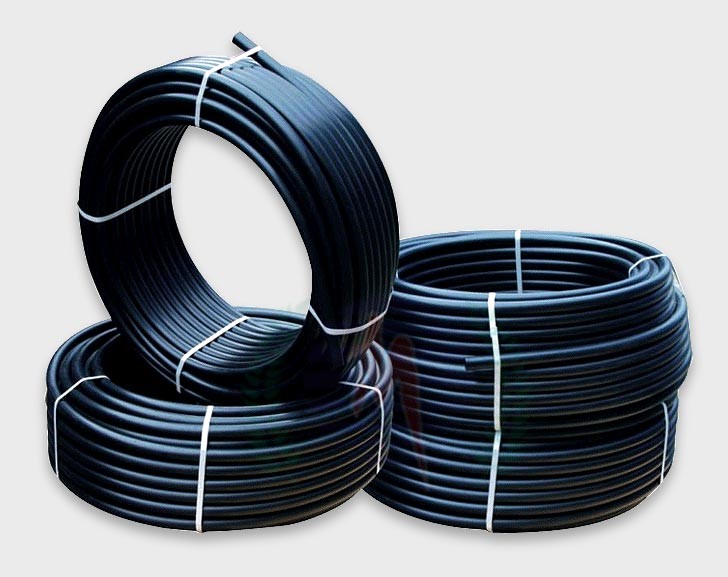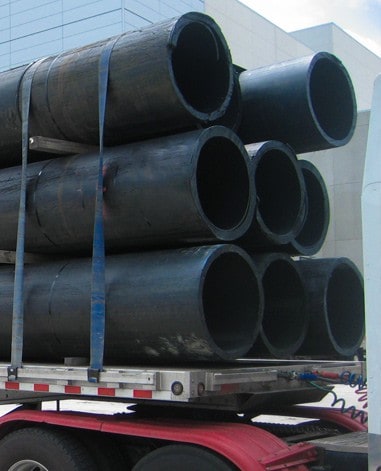Why Partnering with Pipe Supplier American Plastics Midland Ensures Quality Assurance
Wiki Article
Discover the Manufacturing Refine Behind High-Quality HDPE Pipeline and Its Applications
The production process of high-quality HDPE pipes is complex and systematic. It starts with the selection of raw products that improve performance. Following this, ethylene undertakes polymerization to develop material, which is after that formed via extrusion. Quality assurance is critical, making sure that the end product fulfills strict requirements. The trip of HDPE pipelines doesn't finish with manufacturing. Their applications across numerous industries expose a wider value worth examining.Recognizing HDPE: Characteristics and Advantages

High-density polyethylene (HDPE) is a versatile thermoplastic understood for its toughness and resistance to numerous ecological variables. This material shows excellent tensile toughness, making it appropriate for demanding applications. Its low-density framework contributes to a light-weight product, helping with ease of handling and setup. HDPE additionally showcases impressive resistance to chemicals, which minimizes degradation when subjected to extreme substances.
The product's low wetness absorption even more boosts its durability, making it ideal for usage in pipelines and tank. Additionally, HDPE is immune to ultraviolet (UV) radiation, making sure that items maintain their stability even when exposed to sunlight. Additionally, its flexibility allows for the development of detailed forms without endangering strength. The environmentally friendly nature of HDPE, frequently originated from recycled products, includes in its appeal, promoting sustainable techniques in manufacturing. Generally, these homes and advantages make HDPE a preferred option for different commercial and customer applications.
Raw Material Choice for HDPE Manufacturing
The selection of basic materials for HDPE manufacturing is essential to validate the last item fulfills the wanted specifications and quality criteria. High-density polyethylene (HDPE) is largely created from polymerized ethylene, stemmed from fossil fuels such as all-natural gas or crude oil. The quality of these feedstocks considerably influences the mechanical and thermal residential or commercial properties of the final HDPE.Ingredients additionally play a considerable function in enhancing HDPE's efficiency, consisting of anti-oxidants, UV stabilizers, and colorants, which boost durability and resistance to environmental variables. The choice procedure should take into consideration not only the chemical structure of the raw materials yet also their handling characteristics to guarantee reliable manufacturing.
The sourcing of raw materials ought to prioritize sustainability and conformity with ecological guidelines, as accountable methods are critical in today's market. Inevitably, cautious raw material selection lays the foundation for producing high-quality HDPE pipelines ideal for diverse applications.
The Extrusion Refine: Forming HDPE Pipe
The extrusion procedure plays a crucial role in forming HDPE pipelines, starting with careful material preparation techniques that ensure perfect circulation and consistency. Just as essential is the design of the die, which directly affects the final measurements and surface high quality of the pipeline. With each other, these factors contribute greatly to the performance and quality of HDPE pipeline manufacturing.Material Prep Work Strategies
Effective manufacturing of HDPE pipes begins with careful material prep work methods, especially the extrusion process. Throughout this stage, high-density polyethylene material is first dried to get rid of wetness, guaranteeing suitable circulation features. The material is after that fed right into the extruder, where it goes through home heating and melting, transforming into a viscous state. This home heating process is meticulously regulated to keep the product's stability and performance. The liquified HDPE is required with a die, forming it into a continuous pipe form. Correct temperature level monitoring during extrusion is crucial, as it straight influences the material's properties and the final item quality. Once shaped, the HDPE pipe is cooled down and cut to defined sizes, ready for subsequent handling and applications.Die Style Significance
Precision in die layout plays a vital duty in the extrusion process of HDPE pipelines. The die works as the final shaping device, directly influencing the pipe's dimensions, wall surface density, and surface area coating. A properly designed die warranties consistent product flow, lowering issues such as irregularities and vulnerable points. The geometry of the die need to be maximized to fit the details buildings of HDPE, including its viscosity and thermal behavior during extrusion. In addition, the cooling price of the material as it goes through the die can considerably affect the pipeline's structural honesty. Spending in sophisticated die innovation is crucial for producers aiming to create premium HDPE pipes that meet industry criteria and consumer assumptions.Quality Assurance Procedures in HDPE Manufacturing
Although numerous variables influence the quality of HDPE pipeline manufacturing, efficient top quality control measures are essential to guarantee consistency and reliability in the final product. Key high quality control practices include extensive material evaluation, validating that the raw polyethylene meets recognized requirements for pureness and density. During the extrusion process, criteria such as temperature level, pressure, and cooling time are closely kept track of to preserve dimensional accuracy and structural integrityAdditionally, post-production testing is crucial; makers often perform hydrostatic examinations to analyze the pipeline's toughness and resistance to stress. Aesthetic inspections for surface defects further enhance top quality guarantee. Certification from relevant criteria organizations, like ASTM or ISO, provides an extra layer of credibility. By implementing these comprehensive quality assurance steps, producers can reduce defects, enhance performance, and ensure that the HDPE pipelines meet the particular demands of various applications, inevitably bring about consumer satisfaction and count on the item.
Applications of HDPE Pipe Across Industries
HDPE pipes are used across different industries as a result of their resilience and adaptability. In water circulation systems, they guarantee effective distribution, while in wastewater management, they supply reliable services for waste transportation. In addition, agricultural irrigation networks gain from HDPE's resistance to corrosion and adaptability, making it an optimal option for modern farming techniques.
Water Circulation Solutions
A substantial number of industries count on high-density polyethylene (HDPE) pipes for reliable water circulation systems. Known for their toughness and resistance to rust, HDPE pipelines are widely made use of in municipal supply of water networks, farming irrigation, and commercial applications. Their light-weight nature assists in simple handling and installment, reducing labor costs and time. In addition, HDPE pipelines can accommodate different stress degrees, making them ideal for both reduced and high-pressure systems. Pipe Manufacturing Midland TX. The flexibility of the material enables seamless combination into existing facilities, decreasing the requirement for substantial excavation. Moreover, HDPE's resistance to chemical seeping warranties that the water supplied continues to be secure and tidy, making it an ideal selection for keeping the top quality of drinkable water throughout different marketsWastewater Monitoring Solutions
Efficient water circulation systems additionally lead the way for innovative wastewater management remedies, where high-density polyethylene (HDPE) pipes play a considerable function. Popular for their sturdiness and resistance to rust, HDPE pipes are excellent for delivering wastewater in numerous setups. Their flexibility enables very easy setup in complicated atmospheres, decreasing the need for considerable excavation. Additionally, HDPE's smooth indoor surface decreases rubbing, boosting flow rates and performance. These pipes are likewise immune to chemical leaching, making certain that pollutants do not endanger the surrounding atmosphere. Industries, municipalities, and treatment facilities significantly depend on HDPE pipes for their integrity and durability, making them a recommended choice for modern wastewater monitoring systems. This flexibility highlights the essential relevance of HDPE pipelines across various applications.Agricultural Watering Networks
Agricultural watering networks benefit considerably from the usage of high-density polyethylene (HDPE) pipes, which offer effective and trustworthy water distribution to crops. HDPE pipes are lightweight, making them simple to move and mount, while their flexibility enables numerous setups in diverse terrains. These pipes demonstrate exceptional resistance to corrosion, chemicals, and UV radiation, making sure sturdiness in rough agricultural settings. Additionally, their smooth interior surface area lessens friction loss, enhancing water flow and decreasing energy prices connected with pumping. The durability of HDPE pipes, often surpassing 50 years, adds to lower upkeep and replacement expenditures. Farmers progressively count on HDPE pipelines to improve irrigation efficiency and advertise lasting farming techniques, eventually leading to boosted crop returns and resource conservation.
Future Trends in HDPE Pipeline Modern Technology
As the need for lasting and efficient infrastructure expands, innovations in HDPE pipe modern technology are positioned to transform numerous markets. Emerging fads include the combination of clever technologies, such as sensors and IoT abilities, which promote real-time monitoring of pipeline problems, lowering maintenance costs and avoiding leaks. Additionally, the growth of innovative manufacturing techniques, such as 3D printing, is allowing the production of complicated, customized pipeline styles that accommodate specific task demands.The focus on recycling and circular economy methods is driving the advancement of HDPE pipelines made from recycled products, boosting sustainability. Boosted jointing techniques, such as electro-fusion and mechanical installations, are additionally enhancing setup effectiveness and integrity. Ultimately, the growing emphasis on ecological guidelines is pushing makers to adopt greener production processes, ensuring that HDPE pipelines not only satisfy industry criteria but additionally cultivate an even more lasting future for framework advancement.
Regularly Asked Inquiries
Exactly How Does HDPE Contrast to Other Plastic Products?
HDPE outmatches lots of other plastic materials pertaining to durability, chemical resistance, and adaptability. Its low density and high tensile toughness make it optimal for various applications, commonly going beyond options check here in both performance and long life.What Are the Environmental Influences of HDPE Manufacturing?
The environmental impacts of HDPE production consist of greenhouse gas discharges, energy consumption, and prospective air pollution from making processes. Additionally, inappropriate disposal can cause dirt and water contamination, elevating issues about long-term ecological results.Can HDPE Pipeline Be Reused?
Yes, HDPE pipelines can be reused. Numerous facilities accept utilized HDPE for handling, transforming it into new products. This reusing adds to sustainability efforts, lowering plastic waste while saving sources and energy in the manufacturing cycle.What Is the Lifespan of HDPE Pipeline?

Just How Do Temperature Level Variants Influence HDPE Pipe Efficiency?
Temperature variations significantly impact HDPE pipe performance, impacting adaptability and toughness. Heats can lead to softening, while low temperatures may cause brittleness, eventually influencing the pipeline's toughness and viability for numerous applications in diverse environments.Report this wiki page